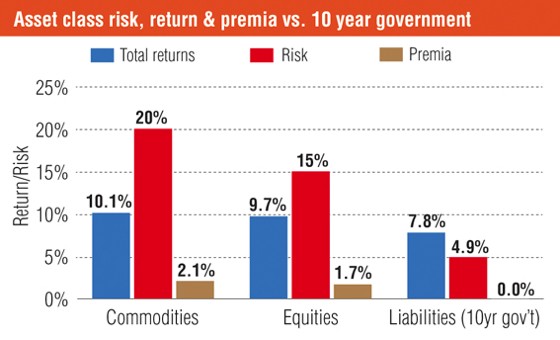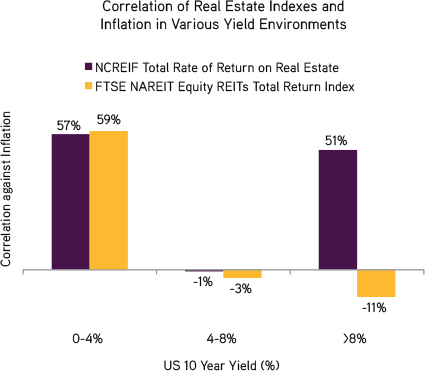Inflation Guide Asset Allocation Based on the Inflation Trend
Post on: 1 Июнь, 2015 No Comment

Inflation Guide: Asset Allocation and the Inflation Trend
This inflation guide explains why the inflation trend should be a major consideration in your portfolio asset allocation. Then we examine each inflation scenario and review asset allocation categories that should be considered and/or avoided for each inflation trend.
Inflation Trend
The inflation trend, or the direction of the rate of inflation, has a profound effect on how a portfolio should be structured. Historical studies show asset categories perform substantially different when the inflation rate is rising from when the inflation rate is declining (disinflation), or when prices are actually falling (deflation).
The trend is more important to portfolio performance than the actual rate of inflation at any particular time. Whatever the current inflation rate is, the valuation of investments has already adjusted to that reality. In other words, the price of an investment already takes into account what the current inflation rate is today.
Empirical evidence shows price movements of asset categories are correlated with the direction of the inflation, not the absolute number at any given time. This means an important aspect of asset allocation investing is keeping track of economic conditions and the long term inflation trend. Our inflation guide examines portfolio asset allocation for three inflation trends: increasing inflation, disinflation, and deflation.
Inflation Guide
Guide to Investing During Increasing Inflation
Increasing inflation can be caused by increases in the supply of money, increased access to credit, or demand that outstrips supply. In reality, inflation is usually caused by all or a combination of these factors.
One of the keys to successful investing is to recognize where the inflation cycle is in the national and global economy. If an investor recognizes an accelerating inflation trend, and believes it will continue, they should consider the following investing guide for their portfolio asset allocation. (Always check with your financial advisor to be sure an investment is right for your individual situation.)
Large-Cap Stocks – Over weight stocks that earn a large portion of their earnings overseas and will benefit by a falling dollar. Underweight quality dividend paying stocks.
Small-Cap Stocks – Historically small companies are more nimble and do well when prices are accelerating. Overweight small growth companies. Underweight small value companies.
Foreign Stocks- International diversification can provide a bonus from a weak dollar. Overweight emerging markets and high growth foreign stocks.
Corporate Bonds- Bonds as a category should be under weighted or avoided. As interest rates rise bond prices fall. Within the bond category high quality bonds should be under weighted; high-yield bonds over weighted.
Treasury and other High Quality Bonds- Avoid
Treasury Bills- have one of the highest correlations to inflation of any investment. The upside can be increasing rates and safety not provided in bonds as interest rates rise. The downside is generally low returns.
Inflation Indexed Bonds – In theory, Treasury Inflation Protected Securities (TIPS), and other inflation indexed bonds, should be over weighted because they have a high correlation with inflation. However the nominal yield is very important. Yes they are providing protection against inflation, but be sure you understand when to buy TIPS because sometimes the nominal yield is negative, making them not as attractive.
Commodities- Over weight commodities because they have the highest correlation to inflation of any investment. This is the best time of the inflation cycle to own commodities.
Gold & Silver The best time of the inflation cycle to own Gold & Silver is when inflation is accelerating. Gold and Silver can provide spectacular returns during these periods.
Real Estate – The best time to own real estate is when inflation is accelerating. But Real Estate has some unique problems too. Many people use leverage to buy real estate. Rising interest rates can hurt investors with variable rate mortgages and put downward pressure on real estate prices.
Investing when inflation is increasing requires an asset allocation that factors in rising interest rates but takes advantage of the factors causing inflation.
Guide to Investing During Disinflation
Disinflation occurs when the rate of inflation is decreasing and provides the widest variety of favorable asset allocation choices for investment portfolios. Historically, both stocks and bonds have done well when the rate of inflation is falling.
Falling inflation rates can be caused by a sound and/or slightly restrictive monetary policy, stable credit conditions, and/or conditions where supply is equal to demand. In reality it is usually a combination of these and other unknown factors that causes inflation rates to begin falling from higher levels.
If an investor recognizes an inflation trend that is decelerating, and believes it will continue, he should consider the following investment guide for portfolio allocations. (Always check with your financial advisor to be sure an investment is right for your individual situation.)
Large-Cap Stocks – Overweight quality dividend growth stocks. Underweight stocks with overseas exposure that might be hurt from a rising dollar.
Small-Cap Stocks – Small companies usually do well during inflation. Over weight small value stocks, underweight expensive growth stocks.
Foreign Stocks – Markets that sell products to the United States usually do well. Emerging Markets in particular are well positioned to supply goods to a healthy U.S. consumer market.
Corporate Bonds – Falling interest rates provide a favorable atmosphere for high quality bonds. Underweight Junk Bonds.
Treasury and other High Quality Bonds – Safe investment that, as interest rates fall, provides capital gains in addition to paying interest.
Treasury Bills – Underweight. Low and falling rates make bonds a better investment.
Inflation Indexed Bonds – Non inflation indexed bonds may provide higher capital gains than TIPS during periods of disinflation.
Commodities – should be underweighted. Only invest in commodities with growing demand and limited supply.
Gold & Silver – Under weight or avoid. Contrary to what most people think, gold and silver are not good long term investments. Their main advantage is they maintain buying power over long periods of time. Falling inflation rates are not the ideal time to own precious metals.
Real Estate- Falling interest rates can provide a great boost to real estate values. Location is a more important factor than ever with inflation rates falling.
Periods of disinflation can provide the most favorable atmosphere for a large number of investment choices. Investing during disinflation requires an asset allocation that takes advantage of falling interest rates and economic stability.
Guide to Investing During Deflation
Deflation is when general prices for goods and services decrease. In other words, deflation is when the inflation rate falls below zero to a negative number. These time periods are rare and have a high correlation with a period of economic depression or severe recessions.
Although deflation takes place only a fraction of the time compared to inflation, it is a critical period of time. Deflation destroys wealth and is the most difficult time period for investing. Time periods of falling prices offer the least amount of profitable asset allocation choices and therefore make choices during this trend more important than any other. It only takes one time of losing a majority of your wealth to guarantee falling short of your long-term investing goals.

Deflation can be caused by restrictive monetary policies, by debt, restrictive credit, or conditions where supply outstrips demand. In reality a combination of these factors usually combine with other unknown factors to cause prices to fall.
Investors who recognize a period of deflation before it happens can make asset allocation choices that minimize the harm or even profit from falling prices. The following is a general asset allocation guide for a deflationary environment. (Always check with your financial advisor to be sure an investment is right for your individual situation.)
Large-Cap Stocks – Avoid or Short.
Small-Cap Stocks – Avoid or Short.
Foreign Stocks – Avoid
Corporate Bonds – Avoid all except companies with the absolute strongest balance sheets.
Treasury and other High Quality Bonds – Overweight because of perceived safety and possible capital gains as interest rates fall.
Treasury Bills – Overweight because of safety and increased buying power as prices of goods and services fall.
Inflation Indexed Bonds – Avoid. Many Inflation Indexed Bonds also index to negative inflation.
Commodities – Avoid.
Gold & Silver – Minimal or Avoid. The only caveat here is if deflation threatens the soundness of the safest investments such as treasury bills; then people may flee to gold.
Real Estate – Avoid. One of the worst investments in periods of deflation. This also makes it one of the best opportunities at the bottom of the deflationary cycle.
Deflation is the most destructive and dangerous of the inflation trends. Investors should take special care to recognize and make the appropriate asset allocation adjustments before deflation takes hold and destroys wealth. Investing during deflation requires an asset allocation that pays special attention to capital preservation.
Asset Allocation and Inflation
Asset Allocation is the most important decision in determining portfolio returns. There are many factors that affect your portfolio asset allocation, but the macro inflation trend is one of the most important inputs in making this important decision.
Investors should periodically make changes to their asset allocation that coincide with the probabilities of each inflation scenario. Using a tactical asset allocation strategy allows investors to change their asset allocation depending on long term inflation trends and valuations of asset categories.
In reality you will rarely find time periods where you will know with certainty where the inflation rate will be in the short term. What an investor can do is assess inflation trends and the long term probabilities of each scenario, then adjust their asset allocation accordingly.
This inflation guide provides a good starting point for further research. Asset allocation is the single biggest determinant of your investment returns. Keep in mind that investments you avoid can be just as important as the investments chosen to take positions in. Use your asset allocation to adapt to the trend and your chances of success will greatly improve.
If inflation is consistently rising, allocate more dollars to investments that benefit from inflation. If inflation is high and falling, allocate more money to the investments that benefit from falling interest rates and economic stability. And finally, if inflation starts to go negative, place more emphasis on capital preservation.
Your chances of meeting your investment goals, and achieving above average rates or return, will greatly increase if you adapt your asset allocation to the current inflation trend.














